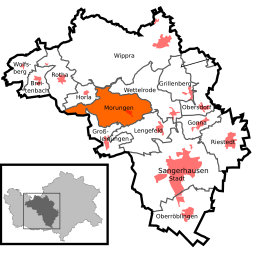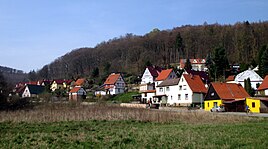Morungen
|
Morungen
City of Sangerhausen
Coordinates: 51 ° 31 ′ 0 ″ N , 11 ° 14 ′ 0 ″ E
|
|
|---|---|
| Height : | 309 m above sea level NHN |
| Area : | 13.5 km² |
| Residents : | 173 (Jan 1, 2013) |
| Population density : | 13 inhabitants / km² |
| Incorporation : | October 1, 2005 |
| Postal code : | 06528 |
| Area code : | 03464 |
|
Location of Morungen in Sangerhausen
|
|
|
View of Morungen
|
|
Morungen is a district of the city of Sangerhausen in Saxony-Anhalt .
geography
Geographical location
The place is on the southern edge of the Harz in the Molkenbachtal. The nature reserve " Gipskarstlandschaft Questenberg " extends south of Morungen , which impresses with its typical karst landscape and rare plants such as orchids and deer tongue.
Incorporations
For exactly 16 years from April 1, 1974 to March 31, 1990, Morungen belonged to the municipality of Großleinungen . After that, Morungen was again a politically independent municipality until 2005. On October 1, 2005, it was incorporated into Sangerhausen.
history
In a register of the tithes of the Hersfeld monastery that was created between 881 and 899, Morungen is mentioned for the first time in a document as the town of Morunga im Friesenfeld, which is subject to a tithing obligation .
The so-called Neu-Morungen Castle , like the Alt-Morungen Castle, which was apparently never completed, was an imperial property and changed hands several times. The latter also included the two Counts Volrad and Gebhard von Mansfeld , who on February 2, 1439 concluded a truce with their uncle, Count Botho zu Stolberg , because of their Morungen Castle . A short time later, he must have come into possession of a quarter of Morungen Castle. On April 9, 1445, Count Botho zu Stolberg announced that he and his uncles, Counts Volrad and Gebhard von Mansfeld, had agreed to cede another of their quarters at Morungen Castle against all his claims to his third at Wippra Castle . Until July 21, 1452, the two Counts Botho zu Stolberg and Günther von Mansfeld had Morungen Castle together with courts and mines administered together. Then they halved the property, including the linen, only the fields remained undivided. Immediately after Count Botho's death, Count Busso von Mansfeld and his brothers and cousins pledged their half of Morungen Castle and its accessories on September 21, 1455 to their brother-in-law, Count Heinrich zu Stolberg, who lent them the sum of 5,000 Rhenish guilders.
On August 20, 1466, Elector Friedrich of Saxony was enfeoffed for himself and in place of his brother, Duke Albrecht and his cousin, Duke Wilhelm of Saxony, Landgrave in Thuringia , with the imperial fief of Morungen Castle and accessories, especially the mines, such as it had previously been owned by the Counts of Mansfeld and Count Heinrich zu Stolberg. On February 22 of the following year, Emperor Friedrich III gave birth. the Count Heinrich zu Stolberg of the oath he had taken together with the Counts of Mansfeld for the Emperor and the Reich because of the Morungen Castle. With this oath he referred him to the Elector Ernst of Saxony and his brother Albrecht. Morungen was therefore a Wettin fiefdom since 1467 and the Counts of Stolberg were the Wettin fiefdoms for half of them.
In 1486 Duke Albrecht enfeoffed the Counts of Mansfeld with their half of Morungen Castle together with the Heldrungen Lordship and Arnstein Castle .
Count Heinrich the Elder left the feudal association. Ä. and his two sons Heinrich d. J. and Botho zu Stolberg when they took their half share in the castle Neu-Morungen with the village of the same name, the Flecken (Groß-) Leinungen and the villages Rotha, Horla and Horlehagen as well as the desolate village places, forests along with accessories for 14,000 Rhenish guilders to the Counts of Mansfeld. The effort to round off the Stolberg possessions in the north-east had failed because of the strength of the neighboring Counts of Mansfeld.
The New Palace was used for many years as a spa facility for the GDR health insurance company , and in March 1989 the new chandelier was installed in the Great Hall. On June 20, 1995 the merchant Peter Klaus Glaser from Munich acquired the still existing castles in Morungen, the so-called old castle and the new castle , formerly built by the barons of Eller-Eberstein, which were renovated.
church
Personalities
Sons and daughters of the place
- Heinrich von Morungen (around 1200) was an important German minstrel
Individual evidence
- ↑ http://www.sangerhausen.de/ortsteile/morungen
- ↑ Municipalities 1994 and their changes since January 1, 1948 in the new federal states , Metzler-Poeschel publishing house, Stuttgart, 1995, ISBN 3-8246-0321-7 , publisher: Federal Statistical Office
- ↑ StBA: Changes in the municipalities in Germany, see 2005
- ^ Reg. Thur. No. 287
literature
- Jürgen Huck : Hildesheim nobles as pledges of the Count of Mansfeld offices Morungen and Leinungen in the 16th and 17th centuries. In: Yearbook for History and Art in the Diocese of Hildesheim 73 (2005), pp. 79-106.






